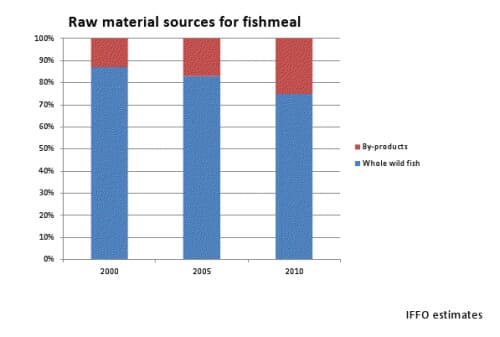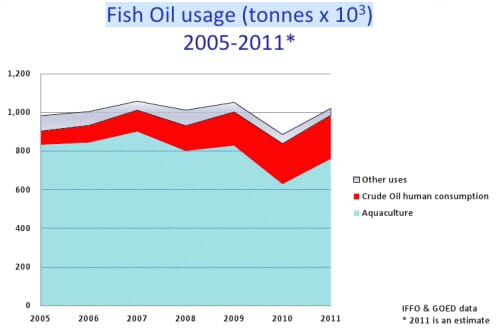Speaking at the World Fisheries Congress, Mr Shepherd said that of the 18,515,000 tonnes of raw material sourced in 2010 to produce fish oil and fish meal, whole fish contributed 13,886,000 tonnes. By products contributed to the remainder of production at 4,629,000 tonnes.
From this, 888,000 tonnes of fish oil was produced, 4,166,000 tonnes of fishmeal and 13,479,000 tonnes of steam.
Whole fish contribution
Between 2001 and 2006, on average a total of 14-15 million tonnes of whole fish a year contributed to marine ingredients production.
Mr Shepherd said that there are three main components to whole fish feed.
Below is the average landed per year over the five year period and the percentage used for fish feed ingredients.
- Industrial grade forage fish, of which 1,175,000 tonnes were landed between 2001-2006, and 100 per cent of the catch used for marine ingredients.
- Second is food grade forage, of which around 90 per cent was used for fish feed production, of an total of 12,162,000 tonnes.
- Finally there is prime food fish, such as herring, sardine, mackerel. A total of 5,708,000 tonnes was landed, with Mr Shepherd estimating that around 40-50 per cent of this being used for fish feed production.
Mr Shepherd stressed that this data was from 2001-2006, and now only around 13 million tonnes of whole fish were used in marine ingredients.

Fishmeal and fish oil production
Figure 1 shows the decline of whole fish used for marine ingredients since 2000. It also shows the increasing use of by-products, which now account for about 25 per cent of marine ingredients. "Thailand is the largest producer of by-products, producing 280,000 tonnes in 2008," Mr Shepherd said.
El Nino heavily influences fishmeal supply, with significant drops in production when occurring. In 2010, El Nino caused fishmeal production to drop to just over 4.1 million tonnes. Last year, fishmeal production increased to 5.2 million tonnes - the largest increase since the 1990's.
"Fish oil production has remained slightly more consistent over recent years," he explained, "although it has steadily declined since the 1980's.
"Fishmeal and fish oil production shows slow decline but continues to be dominated by production in South America. Production in Europe has continued to decrease."
He said the declining trend could be put down to three factors:
- Stricter fishing controls in countries, especially Peru;
- Increased processing for human consumption;
- Decreased seasonal availability due to changes in climate.
Changing uses of fishmeal 1960-2010
In the 1960's fishmeal was predominantly used as a feed ingredient for pig and poultry production. In the 1980's poultry production retained 50 per cent of the market share, with aquaculture claiming 10 per cent.
"By 2010, the situation had turned around completely," said Mr Shepherd, "with aquaculture claiming 73 per cent of the fishmeal market, poultry five per cent and pig production 20 per cent."
Of the 73 per cent of fishmeal used for aquaculture, crustaceans claim the largest share, followed closely by marine fish and salmon and trout.
Mr Shepherd explained that the relative value of fishmeal was gradually increasing, compared to soybean meal. He said this was due to fishmeal now being a specialist and high-value feed ingredient.
Fishoil: fish feed vs human consumption
"Fish oil was traditionally used as a hardened edible," Mr Shepherd explained. "Over the last 50 years its use as a hydrogenated fat has moved to more aquaculture and direct human consumption use."
In 2010, 71 per cent of fish oil was used for fish feed, with 21 per cent used as a redefined edible (such as capsules).
Figure 2 shows that since 2005, the use of fish oil for human consumption has gradually increased, reducing the availability of fish oil for marine feed.
Mr Shepherd said that around 24 per cent of total crude fish oil was used for human consumption in 2011.
With regards to the price of fish oil, Mr Shepherd said that fish oil for human consumption can see premiums of 20 to 25 per cent, as well as it being less price sensitive than the aquaculture segment - making it a much more appealing market.

How does this affect fish feed?
"We have seen the composition of salmon feed changing over the last 18 years. With less fishmeal and fish oil contributing to the diet, alternative proteins and starch have a bigger role to play."
In 1995, fishmeal compromised around 50 per cent of the diet, in 2010 this had reduced to 27 per cent, and it is continuing to fall sharply, Mr Shepherd said, with 2012 usage expected to be around 20 per cent.
Fish oil similarly used to account for 30 per cent of the diet, and nowadays is less than 20 per cent.
Mr Shepherd pointed out that this varies depending on production regions, fish oil use in diets is much higher in Scotland, than in Norway for instance, due to retailer requirements.
Future trends in supply and use of fishmeal and fish oil
Mr Shepherd said he expected to see fishmeal and fish oil supplies decreasing, due to precautionary fish management as well as an increase in use of fish for human consumption.
He estimates at most a static supply of marine ingredients (around five million tonnes a year of fishmeal and one million tonnes a year of fish oil) going forward, as fishery by-products take on an increasingly important role.
"There will be a continuing switch to greater added value use (eg to aquaculture for fishmeal
instead of agriculture; and direct human consumption products for fish oil)."
Mr Shepherd said that this increasing fish oil demand for direct human consumption will mean reduced availability for aquaculture which will therefore result in lower omega-3 levels in aquaculture products.
He said that despite even the so-called "carnivorous" fish becoming more commercially farmed, there are still areas for improvement, with the use of low value/ trash fish fed raw to aquaculture in South East Asia being one of the largest.
"This is a major concern, with a number of initiatives being launched by the FAO."
He concluded saying that the industry must be innovative, recognise research priorities and make better use of marine materials. Recognising and utilising micro-ingredients could be one way to extend the availability and efficiency of marine ingredients, as well as create new added value products.


